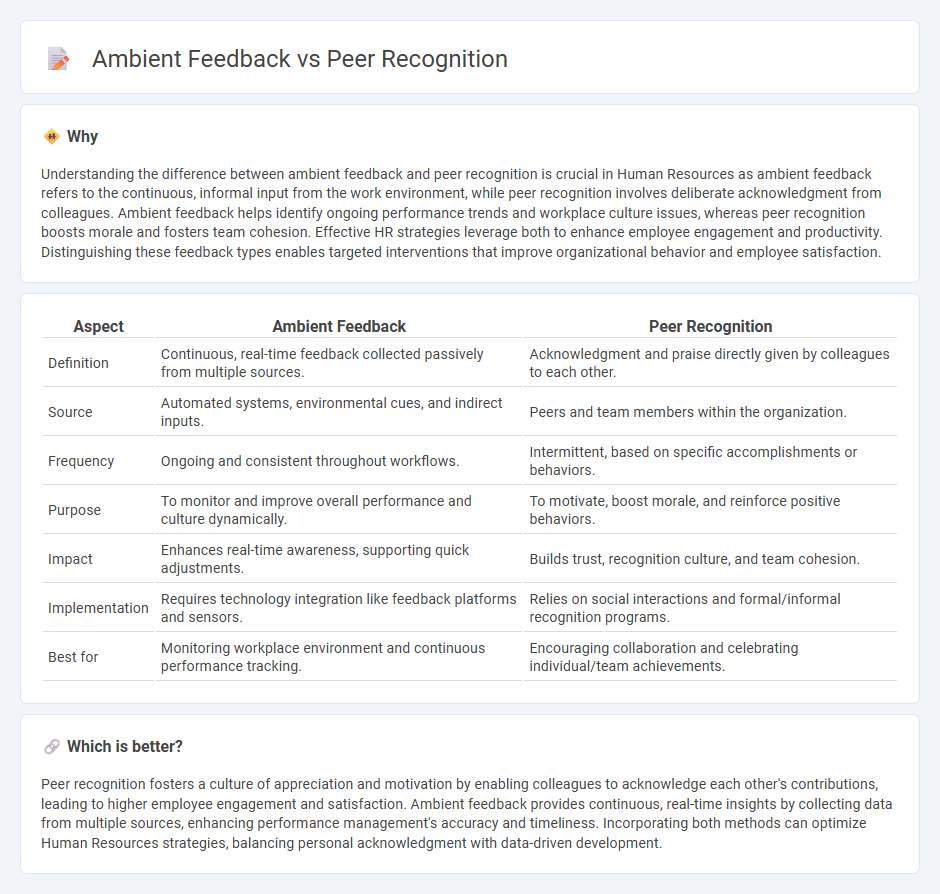
Ambient feedback delivers continuous, real-time insights from multiple sources, enhancing employee performance and engagement through subtle, ongoing communication. Peer recognition fosters a culture of appreciation by allowing colleagues to acknowledge each other's achievements and contributions, boosting morale and teamwork. Discover how integrating both approaches can transform your organizational dynamics and employee satisfaction.
Why it is important
Understanding the difference between ambient feedback and peer recognition is crucial in Human Resources as ambient feedback refers to the continuous, informal input from the work environment, while peer recognition involves deliberate acknowledgment from colleagues. Ambient feedback helps identify ongoing performance trends and workplace culture issues, whereas peer recognition boosts morale and fosters team cohesion. Effective HR strategies leverage both to enhance employee engagement and productivity. Distinguishing these feedback types enables targeted interventions that improve organizational behavior and employee satisfaction.
Comparison Table
| Aspect | Ambient Feedback | Peer Recognition |
|---|---|---|
| Definition | Continuous, real-time feedback collected passively from multiple sources. | Acknowledgment and praise directly given by colleagues to each other. |
| Source | Automated systems, environmental cues, and indirect inputs. | Peers and team members within the organization. |
| Frequency | Ongoing and consistent throughout workflows. | Intermittent, based on specific accomplishments or behaviors. |
| Purpose | To monitor and improve overall performance and culture dynamically. | To motivate, boost morale, and reinforce positive behaviors. |
| Impact | Enhances real-time awareness, supporting quick adjustments. | Builds trust, recognition culture, and team cohesion. |
| Implementation | Requires technology integration like feedback platforms and sensors. | Relies on social interactions and formal/informal recognition programs. |
| Best for | Monitoring workplace environment and continuous performance tracking. | Encouraging collaboration and celebrating individual/team achievements. |
Which is better?
Peer recognition fosters a culture of appreciation and motivation by enabling colleagues to acknowledge each other's contributions, leading to higher employee engagement and satisfaction. Ambient feedback provides continuous, real-time insights by collecting data from multiple sources, enhancing performance management's accuracy and timeliness. Incorporating both methods can optimize Human Resources strategies, balancing personal acknowledgment with data-driven development.
Connection
Ambient feedback fosters a continuous flow of real-time insights, creating a dynamic environment where employees receive immediate acknowledgments, strengthening peer recognition. This seamless exchange enhances team cohesion and motivates individuals by validating their contributions through ongoing peer interactions. Integrating ambient feedback mechanisms into human resources strategies improves organizational culture and drives employee engagement effectively.
Key Terms
Employee Engagement
Peer recognition enhances employee engagement by fostering meaningful social connections and boosting morale through direct acknowledgment of contributions. Ambient feedback provides continuous, unobtrusive insights that help employees adjust performance in real-time, creating a culture of ongoing development. Explore how integrating both peer recognition and ambient feedback can maximize employee engagement for your organization.
Performance Evaluation
Peer recognition directly highlights individual contributions and achievements, enhancing motivation and teamwork by providing specific, constructive appraisals during performance evaluations. Ambient feedback, collected passively from various sources like communication tools and project management software, offers continuous, real-time insights into employee behavior and collaboration patterns. Explore how integrating peer recognition with ambient feedback can revolutionize your performance evaluation approach.
Motivation
Peer recognition directly boosts motivation by fostering a sense of appreciation and belonging through personalized acknowledgment of achievements. Ambient feedback, delivered unobtrusively and continuously, shapes motivation by providing real-time insights that encourage self-improvement without the pressure of formal evaluation. Explore more about how these feedback mechanisms can transform workplace motivation and performance.
Source and External Links
Peer Recognition: Definition and Ideas - This article defines peer recognition as the act of publicly expressing gratitude to coworkers, highlighting its benefits in improving workplace morale and relationships.
15 Peer-to-Peer Recognition Best Practices - The article provides practical strategies to implement effective peer recognition programs, including establishing a structured framework and using inclusive recognition platforms.
Peer Recognition in the Workplace - This piece discusses the importance and methods of peer recognition, which involves employees publicly acknowledging each other's contributions to foster a collaborative work environment.
 dowidth.com
dowidth.com